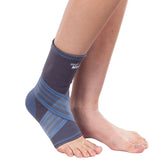5 Pros and Cons of a Reclining Wheelchair
A wheelchair is the best form of transportation for anyone with limited mobility. The standard wheelchair not only makes more places accessible but also helps with being independent. But reclining wheelchairs serve different purposes of mobility.
Considering different mobility conditions, let’s see how a reclining wheelchair can help in your daily life. And what are its advantages and disadvantages?
What is a reclining wheelchair?
A reclining wheelchair consists of a backrest that helps you lie back and provides comfort and support for your back that prevents back aches. You can stretch your legs and lie on the chair with a recliner.
Pros of reclining wheelchair
-
Elevating footrests and Cushioned armrests:
Adjustable footrests and cushioned armrests are a great source of relaxation and help the user be comfortable. An elevated footrest prevents the leg's ache, unresponsiveness, and discomfort.
Elevated footrests are necessarily making your legs flexible to move and relax; even though they seem like a negligible feature, they contribute a lot to the position and comfort level of the user.
-
Prevents back pain:
Continuously sitting in the same position for a more extended period can cause back pain. The reclining feature will help you to relax your back and stretch it to a comfortable position.
-
Prevents pressure sores:
Pressure sores are caused by constant pressure on your body's lower part. The body weight is only concentrated on the lower part of the body when a person in a wheelchair sits for long hours, leading to pressure sores. Reclining is a better position that helps to equally distribute the body weight to all parts of the body
-
Increased comfort that lets changing the posture:
The reclining wheelchairs provide overall comfort to the body by letting the user change their positions. It allows the user to stretch their body, recline back, move their hips to the rested position, extend their legs for increased blood circulation, and give support to the neck.
For wheelchair users, the reclining feature can be the maximum comfort that lets posture change and provides increased comfort.
-
Convenient for caretakers:
It becomes convenient for the caretakers to maintain hygiene and eases their effort, especially while helping the limited-mobility persons with diapers and sanitary care.
Cons of reclining wheelchair
-
Reclining chairs are heavy:
Reclining chairs with multiple features to comfort the user are usually heavy and cannot be self-propelled most of the time. The person with limited mobility needs external help to push the reclining wheelchair when they need to use it for mobility.
-
Reclining wheelchairs are not travel-friendly:
Reclining wheelchairs are designed with greater length, breadth, and weight and are not portable. They can be effectively used in the in-house set-up to comfort the user and are not travel-friendly.
-
Reclining wheelchairs make the person slide in front:
Reclining chairs are difficult for a person with severe conditions. When the person partially reclines back, there are all chances that a person starts to slide in front. If the sliding is not controlled, the user will fall out on the floor since the body's weight pulls them down.
-
Reclining the wheelchair demand self-help:
It is a major con of a reclining wheelchair if the person has a severe leg or back injury and cannot take the support of his leg to pull himself upward to the normal position.
During the reclining position, the person tends to slide slowly downward. Pulling a person upward cannot be done with external help as it takes a lot of strength to bear the whole weight of the person's body to adjust to the position. Hence if the user cannot help themselves to change their posture, a reclining wheelchair is not the right choice.
-
This leads to skin shearing:
When using a reclining chair, users tend to slide downward gradually due to gravity. To prevent sliding, the user pulls his body upwards in the opposite direction to correct his posture resulting in abnormal friction between the skin and the upholstery of the chair that ends up damaging the skin, especially for the elderly when the skin tends to loosen.
Conclusion
It is challenging to choose a suitable wheelchair if it is a reclining or tilt. However, some manufacturers have made this easy by combining both the features of reclining and tilt to provide maximum comfort. Since wheelchairs are a one-time investment it is essential to consider the present and future conditions of the user. We have made the groundwork easy for you by listing the pros and cons.
By understanding the critical touch points of the users, Medequip provides mindful manufacturing solutions for various home healthcare products like Oxygen concentrators, Electric wheelchairs, CGM machines Etc. For more assistance, call us on +91 8951946337







